With regard to SAP Invoice and Goods Receipt Reconciliation described in this article, two aspects related to SAP HANA as a platform are of particular importance:
- SAP HANA enables analytical reporting in real time directly on the basis of non-aggregated transactional data. To facilitate the use of these capabilities by customers with one of the SAP Business Suite systems (with the SAP HANA database), such as e.g. SAP ERP, SAP has created a predefined set of information models/views, the so-called SAP HANA Live;
- SAP HANA is also a stand-alone application platform, since it has its own application server, the so-called SAP HANA XS (Extended Application Services), which enables the native SAP HANA applications to be shared via a web browser.
SAP HANA Live & VDM
SAP HANA Live contains a predefined set of information models also called views, which display transactional data. All information models delivered as part of SAP HANA Live form a virtual data model (VDM). A key advantage of information models is that they perform the necessary transformations and aggregations when the model is running in order to read data from it. VDM consists of four types of models: Query Views, Reuse Views, Private Views and Help Views.
SAP HANA Live information models (namely Query Views) can be consumed by a variety of external client applications, such as SAP BusinessObjects BI or Microsoft Excel. In particular, they can be consumed by the native SAP HANA applications that run on the SAP HANA XS application server.
SAP HANA XS
SAP HANA XS is a lightweight application server that is built into SAP HANA and accessed through HTTP/HTTPS protocols. SAP HANA XS can share via a web browser rich applications prepared in the HTML5 + OData technology that are tightly integrated with the SAP HANA database. It provides a double layer application architecture with a low total cost of ownership (TCO).
Real-time analytical applications
On the basis of SAP HANA Live information models and the capabilities of the SAP HANA platform and XS web server, SAP has prepared a range of so-called real-time analytical applications. These are applications prepared in the HTML5 + OData technology, which run via a web browser on the SAP HANA (XS) platform and collect data from SAP HANA Live information models.
The task of these applications is to support those operations that can be performed better with specific analytical tools. SAP Invoice and Goods Receipt Reconciliation is one of the several real-time analytical applications. Other available applications include DSO (Days Sales Outstanding) Analysis and GRC Analytics. More information about them can be found on the SAP’s website (http://help.sap.com).
Reconciliation of invoices with receipts in the MM module
The reconciliation of invoices with receipts in SAP MM is an operation that must be performed regularly. Open items on purchase clearing accounts (GR/IR accounts) are analyzed on a daily basis in accounting and purchasing departments. If receipts and invoices are consistent with each other, GR/IR accounts are automatically cleared by the system. Open items on GR/IR accounts may be due to various reasons, such as:
- a missing invoice,
- a missing receipt,
- a quantity variance (more goods invoiced than received),
- a quantity variance (more goods received than invoiced),
- a value variance.
In such situations, manual intervention is required. Accounting and purchasing departments must closely cooperate with each other to clarify such variances. This cooperation has not been well supported by system tools so far. The information necessary to effectively carry out the process of reconciling invoices with receipts is scattered in several places in the system. Accounting departments have their reports, and purchasing departments have theirs – sometimes custom reports on open items are created for this purpose.
SAP Invoice and Goods Receipt Reconciliation provides a solution to these problems, since it collects all necessary data in a single place and literally on a single screen, and additionally, it offers a variety of analytical information calculated by SAP HANA on an real-time basis.
SAP Invoice and Goods Receipt Reconciliation
In order to start working with SAP Invoice and Goods Receipt Reconciliation, you must log into the SAP HANA system at: http://<serwer>:<port>/sap/hba/apps/grircm/WebContent/index.html.
A separate SAP HANA user with appropriate authorizations is required – the SAP ERP system user is unnecessary in this case.
After logging in, the user is asked to enter default personalization data and to define a client and a company code whose data will be analyzed in the application. Furthermore, in the personalization data, the analytical information (key figures) to be displayed can be selected. The personalization data are saved on the local computer by a browser. Basically, the application consists of two screens:
- Overview,
- Reconciliation Monitor.
A screen to be displayed is selected using the tab at the top of the screen, just below the application title.
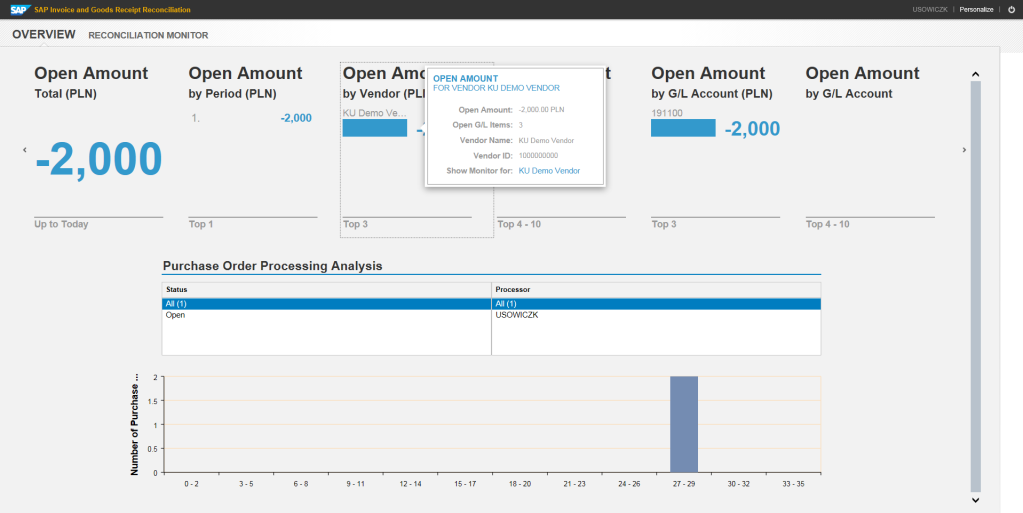
Overview screen of SAP Invoice and Goods Receipt Reconciliation
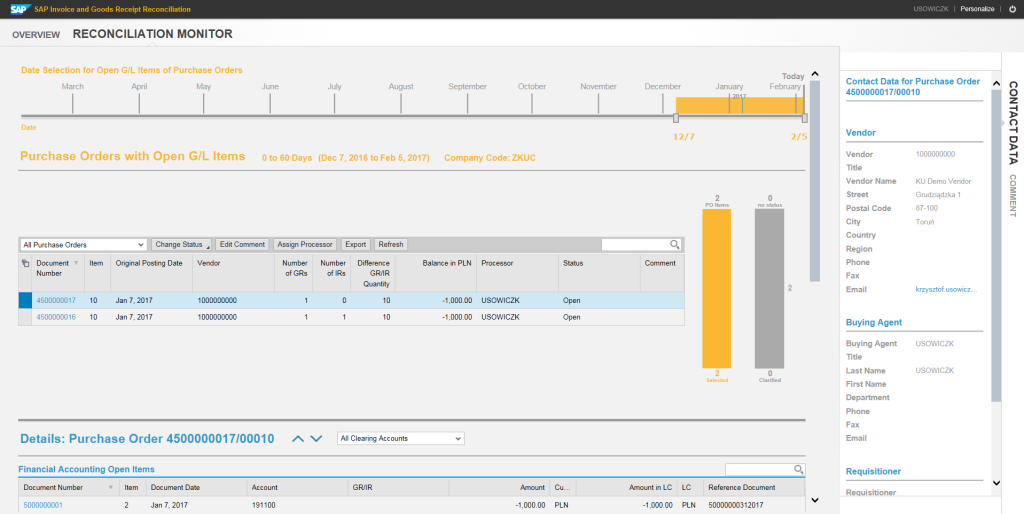
Monitor Reconciliation of SAP Invoice and Goods Receipt Reconciliation
Overview screen
The Overview screen is divided into two parts. In the upper part, tiles with selected analytical information are presented (tiles are selected in the personalization settings). The available analytical information includes:
- an open amount (all),
- an open amount (broken down by periods),
- an open amount (1-3 highest values broken down by vendors),
- an open amount (4-10 highest values broken down by vendors),
- an open amount (1-3 highest values broken down by clearing account),
- an open amount (4-10 highest values broken down by clearing account),
- a number of open items (all),
- a number of open items (broken down by periods),
- a number of open items (1-3 highest values broken down by vendors),
- a number of open items (4-10 highest values broken down by vendors),
- a number of open items (1-3 highest values broken down by clearing account),
- a number of open items (4-10 highest values broken down by clearing account),
- purchase order items (1-3 highest values broken down by processor),
- purchase order items (4-10 highest values broken down by processor).
Tiles enable you to very quickly identify e.g. the vendor who has the largest outstanding balance on GR/IR accounts. In the tile, you can also click on the option of starting the monitor with a filter set on the selected vendor.
Below tiles with analytical information, there is a section of the analysis of processing purchase order items. In this section, numbers of reconciled items (Y-axis) are displayed in a chart, depending on the time when their status was last changed (X-axis). You can set two filters: a status (open/all) and a processor (specific/all). On the screenshot below/above, you can see that the user USOWICZK has been assigned two items originating 27 to 29 days before to be clarified and they have not been clarified yet. This quick preview allows you to easily identify e.g.:
- who is assigned the biggest number of tasks related to reconciliation,
- for whom reconciliation is the most time-consuming activity.
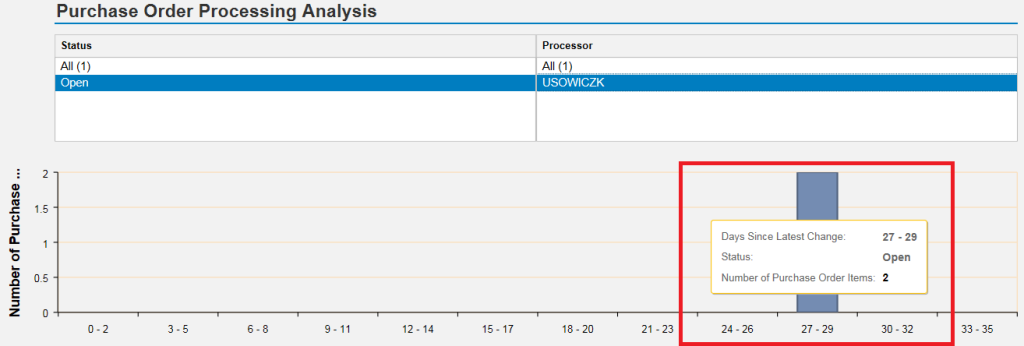
Purchase Order Item Processing Analysis
Monitor screen
You start working with the monitor by setting the period from which purchase order items to be reconciled will be selected. At the upper part of the screen, there is a slider used to set both the start date and the end date (see the screenshot). By default, the system proposes the items older than 14 days to be displayed (default values can be set in the personalization data). In practice, these can be probably items older than a month or two.

Selection of a period for open items on GR/IR accounts
The next screenshot contains a worklist with selected purchase order items for which the system has identified an inconsistency on the GR/IR account. The list shows the numbers of purchase orders, items, numbers of vendors, the number of receipts, the number of invoices, quantity differences, balances of items. In addition, for each item the information visible only in the monitor is displayed (non-SAP ERP information): the persons assigned to the reconciliation of items and statuses of items.
In the application standard, there are three values of statuses that can be assigned to an item at the monitor level:
- an open (not clarified) item,
- a clarified item,
- a critical item.
On the worklist toolbar, you can change the status of an item, assign a person responsible for the reconciliation of items, and enter a comment into the item. The worklist can also be exported to Microsoft Excel and filtered by several predefined.

Worklist

Worklist filters

Status bars
Interesting visual elements are two bars to the right of the worklist. The first one shows the total number of selected items to be reconciled during a specified period. The second one is filled in when the status of the item is changed to “clarified" (green) or “critical" (red).
Clicking on a worklist item results in refreshing the bottom part of the screen with a preview of the history of the purchase order items where all the necessary information about the status of a specific item is gathered.

Purchase Order Item History Preview
The purchase order item history preview is a key part of the monitor. In this section, all receipt documents and invoices (as well as reverse documents – cancellations and corrections) are presented. The amounts from goods receipt documents differ from the amounts from invoice documents by a sign so you can see immediately what values have been used to calculate the balance in the worklist. Below the list of documents, all receipts are gathered on the left side, and all invoices – on the right side. You can click on each document number to open a window with the details of the document.
With such a clear presentation of data on a single screen, an employee of the accounting department or purchasing department can very quickly identify the source of an inconsistency, and as a result, take remedial actions. One of such actions may be a contact with the vendor. The monitor offers support also in this regard. On the right, just click “Contact data" (see the screenshot), and the application will open the side panel where you can see contact data of a vendor, contact data of a responsible buying agent and even data of a person submitting an original purchase requisition. From the side panel, you can send an SMS or an e-mail to the vendor requesting e.g. a correction.
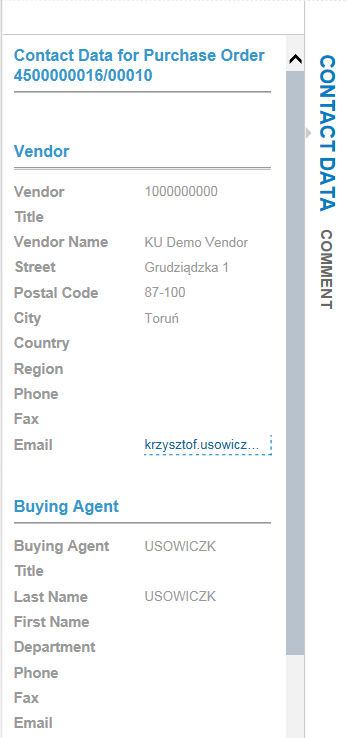
Contact data
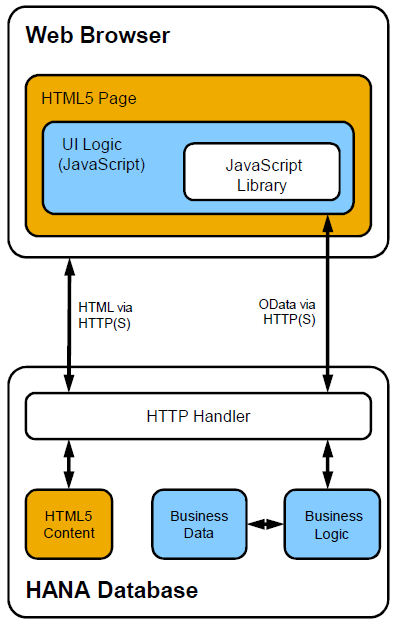
Application Architecture (Web Browser, UI Logic, Java Script, Library HANA Database, Business Data, Business Logic, HTML5 Technology
Application Architecture
SAP Invoice and Goods Receipt Reconciliation is a native SAP HANA application with a two-layer architecture. The visual layer is implemented in the HTML5 + OData technology and is provided in a web browser (Mozilla Firefox, Microsoft Internet Explorer, Google Chrome). The logical layer is located directly in the SAP HANA database and consists of two sub-layers. The first one is made up of information models included in SAP HANA Live that form the virtual data model (VDM). The second one consists simply of the MM module tables (e.g. EKKO, EKPO, EKBE) included in the SAP ERP system schema. To be able to use the application, you need the SAP HANA user; the SAP ERP user is not required. Moreover, it should be noted that this is a desktop application and it is not designed to operate on mobile devices.
After installing, the application is basically ready to use and requires no additional configuration apart from assigning access and authorizations. Additional configuration is necessary if we want to integrate an SMS gateway and telephony with the tool.
Below, there are requirements regarding the installation of the application.
Required systems:
- SAP Business Suite powered by SAP HANA (SAP ERP – SAP ERP 6.0 EHP6 or higher),
- SAP HANA SPS 07 or higher.
Components installed in SAP HANA:
- SAP Invoice and Goods Receipt Reconciliation [HCO_HBA_APPS_GRIRM],
- SAP HANA Live for SAP Business Suite [HCO_HBA_ECC].
Easier reconciliation of receipts and invoices
SAP Invoice and Goods Receipt Reconciliation is an application that streamlines the process of reconciliation of receipts and invoices. The application simplifies communication between accounting and purchasing departments. The presentation of the financial and purchasing data on a single screen and the possibility of marking an item with a status, assigning responsible persons, as well as entering comments contribute to a significant simplification of cooperation between these departments. Additional analytical information provides a broader context that helps employees decide which variances should be addressed in the first place (e.g. the largest, the oldest one, etc.).
Based on the SAP HANA platform and the SAP HANA XS web server, the application has an aesthetic and clear look and feel (HTML5 + OData). Moreover, it very quickly extracts data through SAP HANA Live information models.

